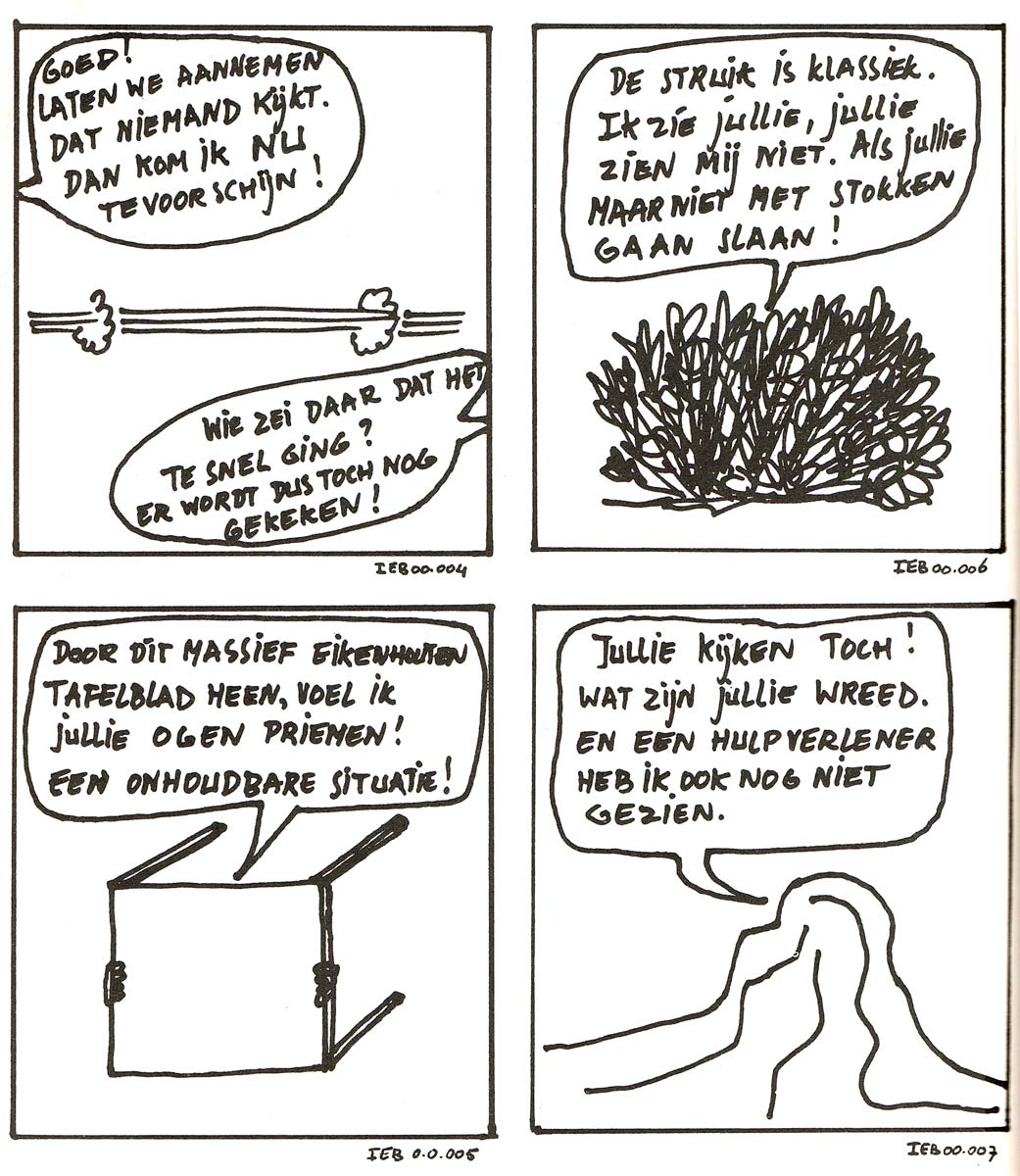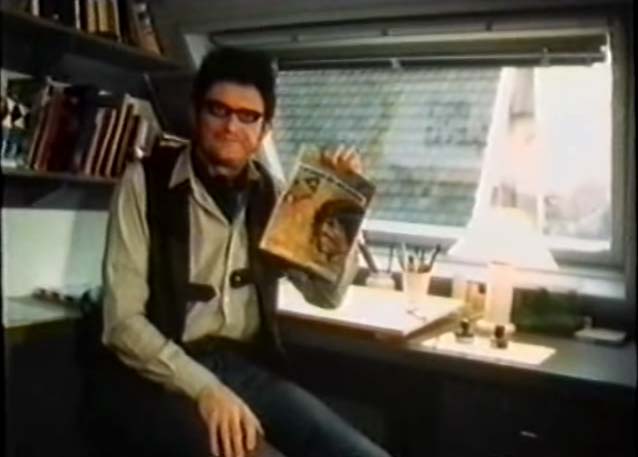'Prof. Dr. Joseph Ischias' (1983).
The Dutch writer and satirist Wim de Bie was most famous as half of the satirical duo Van Kooten & De Bie, while also enjoying a solo career as novelist, musician and blogger. With sharp observations, clever humor and iconic characters, the satire of Wim de Bie and his creative partner Kees van Kooten has proven timeless and highly influential. Between 1963 and 1998, the duo penetrated Dutch culture through television, radio, books, records, musical singles and calendars, down to specific phrases and expressions that have become part of the Dutch language. Starting with their appearances on Dutch radio as the "Klisjeemannetjes" - two men from The Hague talking in clichés - they reached both intellectuals and general audiences through their TV shows, of which the best-known are their 1970s broadcasts around the 'Simplisties Verbond' ("Simplistic Association") and their weekly 1980s satirical news show 'Keek op de Week' ("Peek on the Week"). Playing mostly subordinate sidekicks, reclusive outsiders or rambling hotheads, Wim de Bie's most personal character was the shy and reclusive mister Foppe, who also appeared in several of his books. Of all their collaborative efforts, making comics was hardly any part of their creative output. In the few occasions that a comic strip appeared in one of Van Kooten & De Bie's annual 'Bescheurkalenders', it was usually Wim de Bie making a statement against the genre. Still, for obscurity's sake, they are well worth mentioning.
Van Kooten & De Bie
Just like his creative partner Kees Van Kooten (b. 1941), Wim de Bie was born in The Hague, although two years earlier, in 1939. The two began their collaboration at the local Dalton high school, where they performed in a cabaret show. When in 1963, Wim de Bie began his professional career as editor of the VARA radio youth show 'Uitlaat', he quickly brought his old high school friend along. During broadcasts, Van Kooten and De Bie conducted fake interviews: staged conversations with people from all kinds of professions, in which they seemingly excelled in jargon and professional knowledge. Recurring characters in their sketches were the 'Klisjeemannetjes' ("Cliché Men"), two typical working-class men from The Hague, talking in stock phrases while playing billiards. Kees van Kooten and Wim de Bie were among the first Dutch entertainers to skip theater and start working directly for radio and television. In 1969, they made their TV debut, working as performers and writers for the satirical sketch shows 'Hadimassa' (1967-1972), broadcast by the VARA, and 'Het Gat van Nederland' (1972-1974), on VPRO television.
Between 1974 and 1998, the latter network hosted Van Kooten and De Bie's own TV shows, starting with the broadcasts of 'Het Simplisties Verbond', in which board members Koot and Bie of the Simplistic Association urged for more simplicity in Dutch society, while pretentiousness and other erratic behavior should be reprimanded with the association's symbol, a carpet-beater. During a period of 24 years, Van Kooten and De Bie produced and performed several other TV shows, varying from thematic full evening's programs to half-hour Sunday shows that directly picked up on the news of the week, such as 'Keek op de Week' (1988-1993), 'Krasse Knarren' (1993-1994), 'In Bed met Van Kooten en De Bie' (1994-1995), 'Deksel van de Desk' (1995-1996) and 'Van Kooten en De Bie' (1996-1998). Despite the ever-changing titles, general audiences always referred to these shows as 'Van Kooten en De Bie'. Throughout their TV career, Van Kooten and De Bie worked with the same small crew that included master make-up artist Arjen van der Grijn, director Maud Keus, cameraman Paul van den Bos, sound operator Roel Bazen and editor Ot Louw.
Photo-comic starring "De Vieze Man" and Walter de Rochebrune from the 1983 calendar.
In most of their TV shows, Van Kooten and De Bie appeared as themselves in the studio segments, while playing a wide range of characters in "documentary reports" or "live interviews, shot on location". Through all these versatile creations, the duo provided a veritable mirror of Dutch society. Some sketches were directly inspired by current news events, others were more timeless. But all were masterful satire, which appealed to viewers of all layers of society. Among their countless unforgettable characters were the The Hague scoundrels Jacobse & Van Es, the middle-aged youngsters Koos Koets & Robbie Kerkhof, the elderly brothers Arie & Gé Temmes and a filthy pervert named "De Vieze Man" ("The Filthy Man"). While Van Kooten usually performed the more eccentric and erratic figures, De Bie was at his best when playing empathic sidekicks, such as the simple rogue Tedje van Es, the frustrated mother's boy Frank van Putten or the gullible Gé Temmes. His other characters were outsiders like the hermit Walter de Rochebrune and the tramp Dirk, or the raging and rambling German teacher O. den Beste. Unlike Van Kooten, whose female characters were usually loudmouthed and grotesque, Wim de Bie was capable of transforming into stylish, beautiful women, such as TV host Mémien Holboog and the silent rebel Thea Ternauw. Wim de Bie's most personal character was the shy and reclusive mister Foppe, whom he considered an alter ego.
Legacy
Over the decades, Kees van Kooten en Wim de Bie have received many awards and almost unanimous praise in the press. To this day, archive footage of their sketches generates high TV ratings. Their personal YouTube channel is among the most popular in the Low Countries. In terms of intellectual status, they can be considered the Dutch equivalent of the British Monty Python team, even though their comedy style was more realistic and conventional. Many Dutch and Flemish satirists have been influenced by them, and the general public loves them equally much. In 2004, they appeared at the 30th place in the election of "De Grootste Nederlander" ("The Greatest Dutchman"). The surest sign of their enduring legacy is the fact that they introduced many untranslatable catchphrases and neologisms, many of which found their way into the official Dutch dictionary. Because of this achievement they were made honorary members of the Genootschap Onze Taal (Our Language Society) in 2007.
Other media
As the popularity of their TV shows increased, Van Kooten and De Bie also conquered other media. They recorded seven comedy records and a handful of novelty songs, either as themselves or as one of their characters. In the TV shows, Wim de Bie regularly performed a satirical song on the piano. Compilations of their TV shows have appeared on video, DVD and their own YouTube channel. Between 1972 and 1986, the duo also published fourteen editions of their annual tear-off calendar, 'De Bescheurkalender', containing jokes for every day of the year. Most of the covers of these books, records, calendars and DVDs had a graphic design by Piet Schreuders.
Comics
In some editions of Koot and Bie's 'Bescheurkalender', Wim de Bie made a humble attempt at drawing comics. Far from being a skilled draftsman, he had no intention or pretense to make it look professional, but merely wanted to satirize the comic industry. In the 1981 calendar, "Bie" wrote to "Koot" that he had developed a comic character, who could continue its adventures for 35 calendars to come. He also wrote that he had grown up reading classic Dutch newspaper comics like Pieter Kuhn's 'Kapitein Rob', Henk Kabos's 'Tekko Taks' and Wim Meuldijk's 'Ketelbinkie', but didn't feel much affection towards popular Franco-Belgian comic series like Hergé's 'Tintin' and Morris' 'Lucky Luke'. What followed was a series of 11 daily panels with merely text balloons, in which the main character didn't dare to show itself. These panels were all signed "IEB". De Bie's drawing skills - this time signed with "Weedebee" - reappeared in the 1983 editon of the calendar, in which he brought the column of media sociologist 'Prof. Dr. Joseph Ischias' in comics format. These episodes were made in a similar naïve and non-pretentious style as the late 1970s cartoons of Dutch writer Remco Campert.
'Prof. Dr. Joseph Ischias' (1983). The professor fears that the craze around the video game Pacman might enter the world of comics too, and he turns out to be right.
Comic artist "Hujé"
Another showcase of De Bie's disdain of comics could be seen in a 1984 episode of Van Kooten & De Bie's TV show. Here, De Bie played comic artist Hubert Jegemans, AKA Hujé. "Hujé" was portrayed as the author of works like 'Carnaval der Ontzielden' ('Carnival of the Soulless', actually one of the 'Archie Cash' books by Malik) and 'De Blanke Neger' ('The White Negro', actually a 'Blondin et Cirage' title by Jijé), who defends the racism, violence and sex in his work. As the interview progresses, the perverted artist with the Belgian accent starts drooling over his sick fantasies. Despite being a one-time character, he also appeared in the Van Kooten & De Bie compilation photo book 'Ons Kent Ons' (1993).
Wim de Bie as comic artist Hujé (7 March 1984).
Solo career
Although most of their work was done collectively, both Van Kooten and De Bie worked independently on novels and other books. While Kees van Kooten spent his novelist career writing autobiographical work, De Bie's books and story collections usually centered around one of his characters, mostly the shy mister Foppe. In addition, De Bie released solo music records like 'De Bie Zingt' (1984), 'De Bie Zingt A Capella' (1990) and 'De Fluiten van Ver Weg: De Wereldmuziek der Cananefaten' (1996).
When Van Kooten decided to retire from his TV work in 1998, De Bie initially pursued a solo career on VPRO television. Between 1998 and 2001, he hosted several new satirical TV shows, of which his collaborations with actress Annet Malherbe were the most notable. Still, his unique chemistry with Van Kooten was sorely missed. Even in old age, De Bie kept a keen interest in new technology though. Between 2001 and 2008, he was one of the first in the Netherlands to maintain a weblog, called Bieslog, and later continued to give his views on current affairs through his Twitter account. His last major media activities were his appearances as "National Mental Coach" of the Netherlands in 2010. In March 2023, Wim de Bie passed away from Parkinson's disease at the age of 83.
On 23 March 2012, Wim de Bie attended Gallery Lambiek to present the book 'Colonel Baxter's Dutch Safari' to British cartoonist Glen Baxter, whom he greatly admired.








